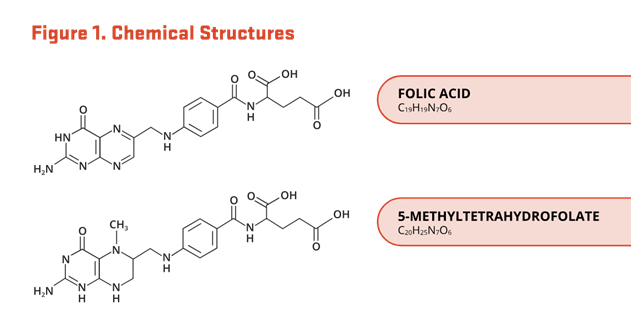Folate vs Folic Acid: Is There a Difference?

Whether you’re an expecting mother or an individual looking to support your overall nutrition needs, you’ve probably heard the term “folate” or “folic acid.” But have you ever wondered about the difference between folate and folic acid, or what are the benefits of folic acid? If so, then this article is for you!
What is folic acid?
Many people are familiar with the need to consume adequate folic acid or folate during pregnancy because it reduces the risk of fetal development defects of the brain and spinal cord. But folate, or vitamin B9, is an essential water-soluble nutrient for all of us: women, pregnant or not, men, adults, and kids.
Folate acts as a master key in the body for a process called “methylation,” turning on and off the individual biological switches for a whole host of body systems. When the methylation cycle is working optimally, it has a significant positive impact on the biochemical reactions that regulate our cardiovascular, neurological, reproductive, and detoxification systems. More specifically, methylation plays a role in normal DNA production, histamine metabolism, estrogen metabolism, eye health, fat metabolism, cellular energy, and liver health.
Folate also contributes to the production of neurotransmitters like serotonin, dopamine, epinephrine, and norepinephrine, making it a key nutrient for healthy mood as well.*
What’s in a name: Folate vs. folic acid
The terms “folic acid” and “folate” are often used interchangeably. However, these compounds are not identical and have different health implications, especially given that approximately 60 percent of individuals have an MTHFR gene variant that limits the body’s ability to process folic acid. Let’s break it down with a quick chemistry lesson.
Folates are naturally occurring, reduced forms of vitamin B9 that exist in food primarily as tetrahydrofolate, with additional glutamate amino acid residues attached, making them polyglutamates. Folate is relatively unstable, especially when subjected to heat and light, making dietary folate typically less bioavailable or absorbed.
Folic acid is the fully oxidized, synthetic form of folate – with just one glutamate residue – that is traditionally used in food manufacturing when fortifying foods and in many nutritional supplements. In this form, it has no biological activity and must be metabolized and converted by the liver to be used throughout the body.
Some folic acid supplements, including Thorne’s, contain folate in the 5-MTHF form, otherwise known as methylfolate, making it readily available to the body. 5-MTHF passes the gastric barrier and is absorbed mainly in the small intestine by a carrier-mediated mechanism that ensures higher folate uptake.

Source: Linus Pauling Institute
Folate foods & supplement sources
Luckily there are many different foods that can help you fill up on folate, and a variety of Thorne supplements contain 5-MTHF for a bit of dietary insurance. Dark green and leafy green vegetables like spinach, brussels sprouts, and asparagus, and nuts, beans, peas, and rice are some great naturally occurring sources of folate in the diet. Just a half cup of cooked spinach provides 33% of your daily needs! Spinach artichoke dip anyone?
For those aged 14 and older, the Recommended Daily Allowance (RDA) is 400 mcg of Dietary Folate Equivalents (DFE). This classification of DFE is used to reflect the differences in bioavailability of folate vs folic acid. Because supplemental sources of folic acid like 5-MTHF are considered more potent, they will have a higher DFE than food sources of folate. For example, on the supplement facts label of Thorne’s Basic Prenatal, it shows that 1 mg of 5-MTHF provides 1.7 mg DFE.

During pregnancy and lactation, the RDA increases to 600 and 500 mcg respectively to help meet the increased needs of mom and baby.1 To help reduce the risk of neural tube defects in early fetal development, in 1998 the FDA began requiring grain products like breakfast cereals, breads, and pastas to be fortified with folic acid. This fortification initiative helped Americans increase their total folic acid intake by almost 200 mcg per day due to the wide variety of grain products in the typical American diet, decreasing rates of neural tube defects by 28 percent.2,3 Big wins for public health nutrition!
The Thorne difference
If you’re looking to supplement your folate intake look no further than Thorne’s extensive product portfolio. You’ll find folate as a single-ingredient product, in multivitamins, B complexes, and products designed to support healthy methylation and optimal energy levels.* In each of these products, Thorne uses 5-MTHF to bypass the MTHFR conversion step and provide the most tissue-ready and biologically active form of folate for the multitude of functions it impacts throughout the body.*
Interested in learning more? Check out Thorne’s Take 5 Daily blog to learn more about folate and its role in health.
References
- Institute of Medicine. Food and Nutrition Board. Dietary reference intakes: Thiamin, riboflavin, niacin, vitamin B6, folate, vitamin B12, pantothenic acid, biotin, and choline. Washington, DC: National Academy Press; 1998.
- U.S. Food and Drug Administration. Food standards: Amendment of standards of identity for enriched grain products to require addition of folic acid. Federal Register 1996;61:8781-97.
- Williams J, Mai CT, Mulinare J, et al. Updated estimates of neural tube defects prevented by mandatory folic Acid fortification - United States, 1995-2011. MMWR Morb Mortal Wkly Rep 2015;64:1-5.

